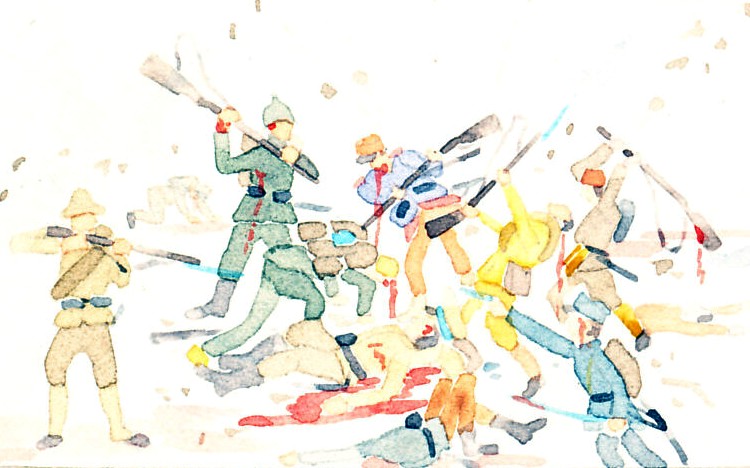An advertising card of the Romanian Army from the series Armées des États Balcaniques, published in 1910.
Shown, from left to right, a non-commissioned officer and artillery gunners, a staff officer, a rosiori (a red hussar), a mounted policeman (dismounted), a kalarachi (territorial reserve cavalry), a chasseur (venatori or rifleman), and an infantryman.

Véritable Extrait de Viande Liebig.
Voir L’Explication au verso.
Reverse:
Roumanie
Le service militaire general est obligatoire pour les Roumains. Il commence avec la 21me année et dure 25 ans. Le service actif est théoriquement de 7 ans, mais se décompose en réalité en une période de service effectif de 3 à 5 ans et en une seconde période de 2 à 4 ans de congé. L’armée roumaine se divise en quatre corps comprenant 3000 officiers, 48,000 hommes et 360 pièces d’artillerie. Sur pied de guerre, l’effectif pourrait être porté à 3500 officiers et 150,000 hommes auxquels il convient d’ajouter 50,000 miliciens et territoriaux. – Au recto de cette carte figurent, en commençant par la gauche : un sous-officier d’artillerie et des artilleurs, un officier d’état major, un hussard rouge (rosiori), un homme de la gendarmerie montée, un hussard kalarachi, un chasseur (venatori), et un fantassin.
Romania
General military service is compulsory for Romanians. It starts at age 21, and lasts 25 years. Active duty is theoretically seven years, but in reality is divided into a period of active service of 3 to 5 years and a second period of 2 to 4 years of leave. The Romanian army is divided into four army corps consisting of 3,000 officers, 48,000 men and 360 artillery pieces. On a war footing, the number could be increased to 3,500 officers and 150,000 men to which should be added 50.000 militia and territorials [home guard]. - The front of this card shows, starting from the left: a non-commissioned officer and artillery gunners, a staff officer, a rosiori [red hussar], a mounted policeman [dismounted], a kalarachi [territorial reserve cavalry], a chasseur (venatori) [rifleman], and an infantryman.
Armées des États Balcaniques. Roumanie.
Armies of the Balkan states. Romania.
Véritable Extrait de Viande Liebig.
Ne concourt plus dan les Expositions depuis 1885.
L’Extrait de Viande Liebig sert à preparer ou à améliorer toutes
Other views:
Larger, Back
